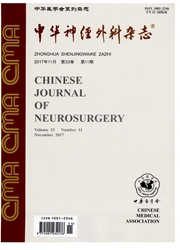

 中文摘要:
中文摘要:
目的探讨侵袭性垂体腺瘤的手术疗效及治疗策略。方法回顾性分析武汉同济医院神经外科垂体瘤组37例海绵窦侵袭性垂体腺瘤的临床疗效。结果37例均行手术治疗,其中经鼻蝶27例,分期经鼻蝶2例,经颅4例,联合人路4例。全切除11例,次全切除14例,部分切除12例。术后症状改善28例,缓解5例,未愈4例。术后辅助治疗11例。随访5~51个月,中位时间25个月,复发13例,复发率35%,复发患者平均无复发生存时间35.8个月。肿瘤切除程度,术后是否予以辅助治疗以及是否有肿瘤包绕颈内动脉与预后明显相关。结论侵袭性垂体腺瘤采取以手术为主的综合治疗策略,经鼻蝶入路可以成为侵袭性垂体腺瘤手术治疗的首选方式,术后辅助治疗能够延长无复发生存时间。
 英文摘要:
英文摘要:
Objective To analyze the clinical characteristics of invasive pituitary adenomas, and discuss the clinical outcome and therapeutic strategies. Methods To summarize clinical characteristics and therapeutic effect of invasive pituitary tumor involving cavernous sinus through studying 37 cases who had the full MR imaging findings, endocrinology and pathology data and follow - up information retrospectively. Results Among the 37 patients, 27 cases were underwent trans -sphenoid surgery, 2 staged trans - sphenoid surgery, 4 trans - sphenoid combined with transcranial operation and 4 transcranial surgery. 11 patients had achieved gross total resection, 14 subtotal resection, 12 partial resection. 11 cases received post -operation adjunctive therapy; 28 patients improved, 5 alleviated and 4 unrecovered. Recurrence during the follow up occurred in 13 patients (35%). The average recurrence -free survival was 35.8 months for a median follow - up of 25 months. Recurrence was associated with the degree of tumor resection, post - operation adjunctive therapy and encasing the internal carotid arteries. Conclusions Aggressive pituitary adenomas should be taken multimodality therapy: trans -sphenoidal surgery should be the first choice postoperative adjunctive therapy can improve the clinical outcome and prolong recurrence -free survival.
 同期刊论文项目
同期刊论文项目
 同项目期刊论文
同项目期刊论文
 期刊信息
期刊信息
